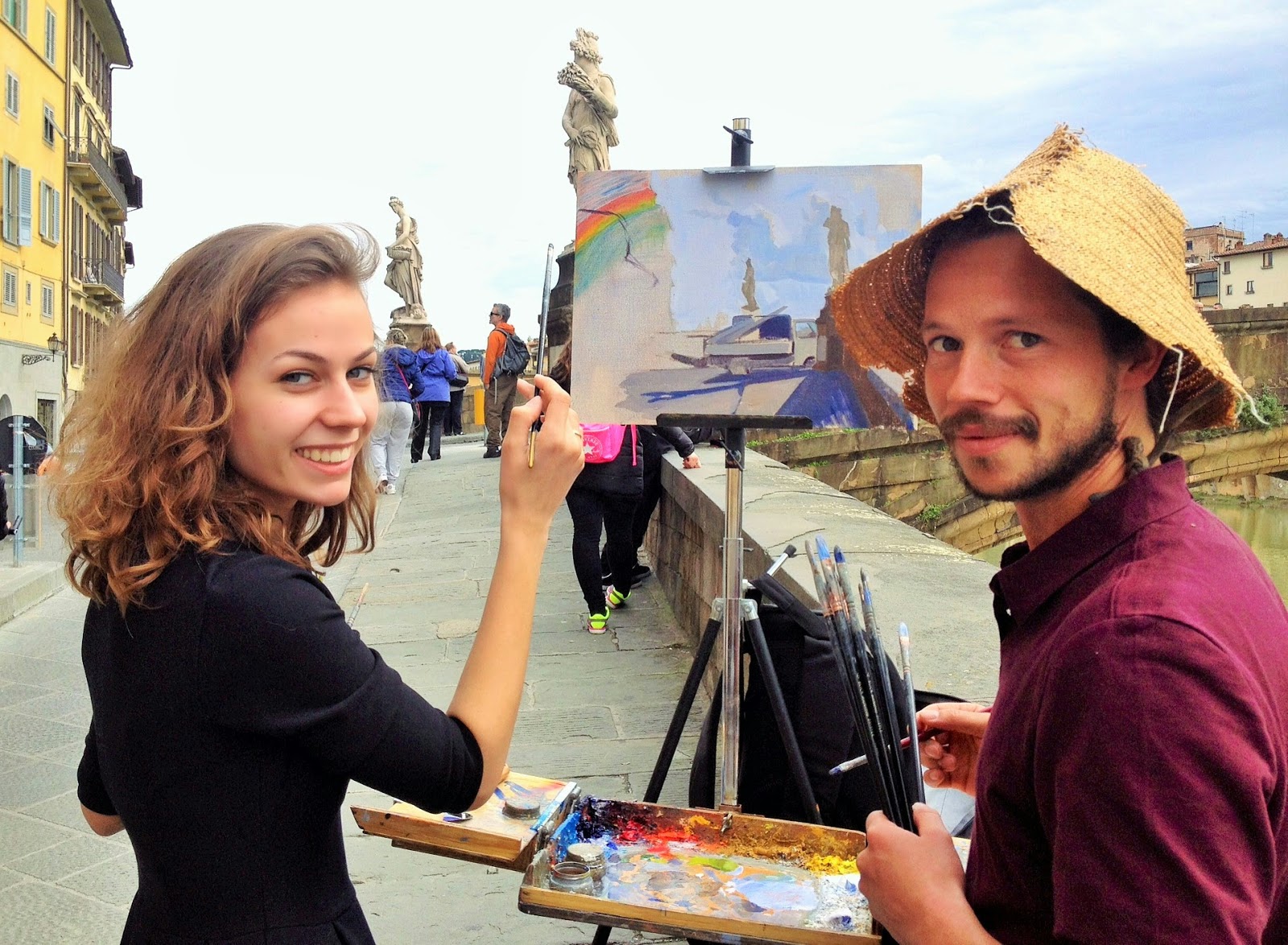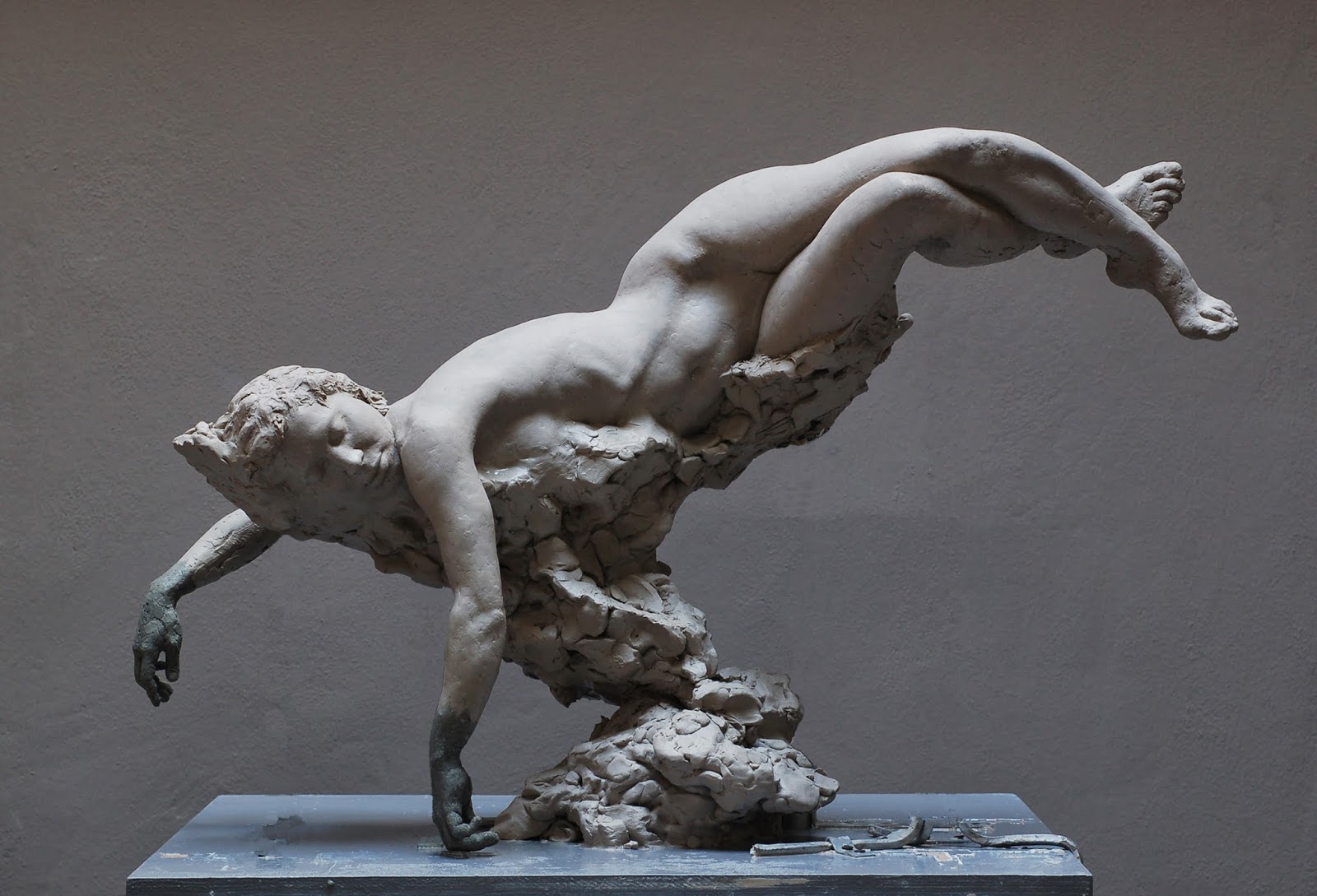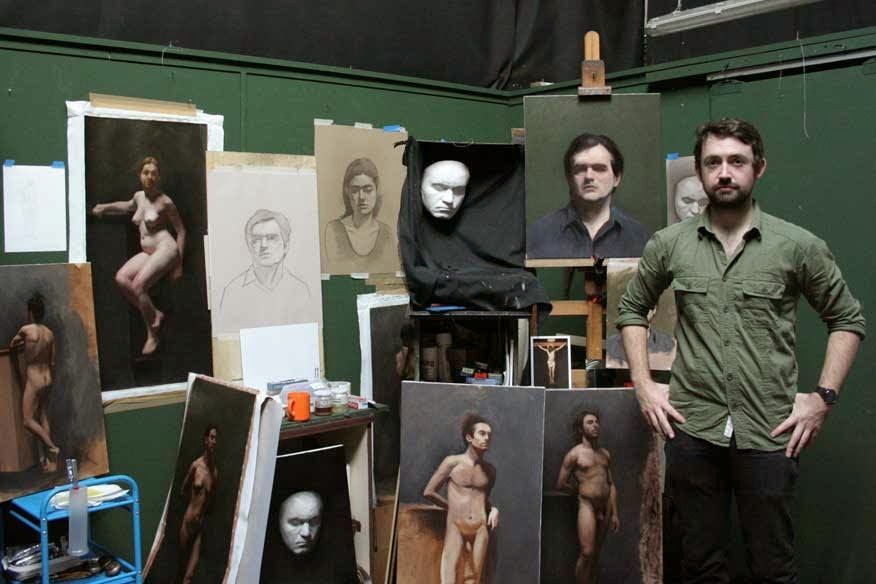Florence is magical. Call me biased, but I would argue that its artistic community is too.
Just last week I was wandering along the Arno when I bumped into my good friend Timothy McGuire. He was putting the finishing touches to a small oil painting following his first day of teaching a plein air course with fellow artist Joseph Altwer.
.jpeg) |
| Timothy McGuire painting the Ponte Santa Trinita |
Joe had set himself up on the opposite side of the Ponte Santa Trinita and, with teaching finished for the day, he was all set to develop his own demonstration piece. Well, then I interrupted. Rather than offer a gruff greeting and turn back to his work, Joe handed me a series of brushes and invited me to join in. Poor chap must have assumed I’d trained in painting rather than sculpture! Undeterred, I spent a magical afternoon sabotaging my half of the board whilst chatting with Joe.
.jpeg) |
| With Joe Altwer, painting the Ponte Santa Trinita |
Later that evening, I was delighted to relay this unexpected event as I proudly presented the painting to my friend Amanda Granberg. And that was the end of that.
Or, at least it could have been. Instead, I found myself questioning what motives painters to paint from life. After all, their product is two-dimensional – why not simply refer to a photograph? Luckily, my jaunt to Florence held a professional purpose: to record a series of interviews with artists. Perhaps they could provide answers!
My first interview was with Nelson White. Born in 1932, Nelson is a third generation painter who trained under the esteemed artists Nerina Simi and Pietro Annigoni.
My first interview was with Nelson White. Born in 1932, Nelson is a third generation painter who trained under the esteemed artists Nerina Simi and Pietro Annigoni.
 |
| Nelson White for digiQualia |
It was therefore unsurprising that, when questioned about painting from life, Nelson’s response held echoes of Simi and Annigoni’s teachings. Simi’s father studied under Jean-Léon Gérôme. It was to Gérôme that Nelson referred to when expressing that, potentially, one can paint well from photographs. However, Nelson was also quick to add that Gérôme was experienced in a way that many artists today are not.
Nelson continued on to share his belief that painting from photographs can strip a subject of its emotion. That inevitably, when an artist trained to work from life turns to photography his work will worsen. It seems that this sentiment was shared by Annigoni who spoke of the camera as a barrier. A barrier which would prevent the artist from receiving a direct impression to interpret.
| Bagno La Salute by Nelson White, 2013 |
However, Maureen Hyde, a principle instructor in the Intensive Drawing Program at The Florence Academy of Art (FAA) pointed out that there are instances when taking photographs is necessary. As I probed further Maureen warned that I was entering dangerous territory. That this is a much debated, ‘big and long topic’. That there is no right or wrong and she could only offer her own understanding.
 |
| With Maureen Hyde for digiQualia |
In Maureen’s experience, patrons are not always available to sit for the crucial hours needed to produce a high-quality portrait. It is in these moments that Maureen will take a series of photographs and make some sketches. However, it is to these sketches that she prefers to refer. For, working from life is her ‘ideal, it is when the magic happens.’ Over time Maureen is able to extract enough information to render both depth and profundity. Compared to this, a photograph is no more than a moment of existence to Maureen.
 |
| The Fiddler II by Maureen Hyde, 2010 |
I also interviewed Robert Bodem, the FAA’s Principle Sculptor Instructor. Although not a painter, Rob certainly has an opinion to share! ‘Those who have too strong views on the matter will do bad work from both.’
 |
| La Marionetta by Robert Bodem, 2007 |
Rob went on to explain that working from both life and from photographs facilitates good results should the artist know how to achieve them. Then, Rob drew a parallel that I had not considered before. When a model is posed in a controlled environment, and an artist records this using sight-size, it is similar to looking at a photograph in the studio. While there may be more to capture when working from life, it does not inevitably mean that the artist is honestly representing life.
So, like Maureen, Rob considers photography as an aid rather than a means to an end. But an aid limited to tell the artist only what he does not already know.
 |
| With Robert Bodem for digiQualia |
Rob could not name many professional sculptors who work exclusively from photographs. Although on occasion he has been known to use callipers, Rob prefers to rely on intuition while working from life. Just look at Feline… the languid pose was inspired by the live model stretching out whilst on a break!
 |
| Feline by Robert Bodem, 2014 |
The remaining interviews I conducted are part of an ongoing digiQualia project following four young artists from The Alpine Fellowship. The brainchild of Alan Lawson, this brings together figurative painters and philosophers. Inaugurated last year in the Swiss Alps, last year’s focus was to question ‘the way in which the painter works, and lives, and how the world is revealed’.
The first two of these interviews were a particularly bizarre experience. By chance, it meant questioning my previous flatmate Benjamin Arnold and his girlfriend Jennifer Keltos. Just last year they were helping me find my feet in Florence and I had come back to grill them!
The first two of these interviews were a particularly bizarre experience. By chance, it meant questioning my previous flatmate Benjamin Arnold and his girlfriend Jennifer Keltos. Just last year they were helping me find my feet in Florence and I had come back to grill them!
 |
Benjamin Arnold in his studio for digiQualia |
Like Rob, Ben feels uneasy when artists champion ‘fundamental beliefs’. As a young man, with ’50 good years of painting ahead’, Ben asked why shouldn’t he consider photography his friend? Doing so does not mean turning his back on working from life. It does not mean forgetting all that he has learnt over the last three years at the FAA. Instead, Ben believes that programs such as Photoshop may open up exciting possibilities for representational artists.
 |
With Jennifer Keltos for digiQualia |
Similarly Jen prefers to work from life but reflects that different art suits different techniques. Through the work of her three favourite artists, Andrew Wyeth, Alphonse Mucha and Gustav Klimt, she explained why this is so. Wyeth’s work explores life – so why should he not work from life? She interprets the paintings of Mucha and Klimt as imagined, that is conceived in the mind rather than grounded in reality. Perhaps these artists found photography useful when translating their idea to a tangible image. Perhaps, one day, she may too.
 |
| Lavey-Village by Jennifer Keltos, 2013 |
Though to tell Jamie Coreth to paint from a photograph is to deprive Rudolph of his red nose. When working from life, Jamie is assaulted by a range of visual stimuli that he feels neither words nor a photograph can capture. The changing light and atmospheric conditions, his own feelings and subconscious combine to create an expression based on solely on experience.
 |
| Portrait of Jim Penfold by Jamie Coreth, 2012 |
When charged with copying a photograph his involvement is lost. Jamie argues that one becomes ‘confined to a set of shapes and colours’. He is left with the challenge of making a photograph appear as if it is not what it is. The fun disappears.
 |
Painting of Lucy by Jamie Coreth, 2014 |
Last but not least was my interview with Amy Moseley. For Amy, music is of paramount importance. She explained that if one is given only two notes and asked to compose a score, that score has far less possibilities than if one is given a complete scale, or superior still, the full range. Through this metaphor Amy argues that, by painting from a photograph, one’s work can only ever be as good as that photograph, it cannot surpass it.
Amy then recalled the advice of Oscar Wilde – that to observe the subject over a long period of time allows one to see the sitter in all their beauty and ugliness before deciding what to portray. Thus, by painting from life Amy feels that she is able to ‘harness much more life.’
 |
| Giovanna by Amy Moseley, 2013 |
All too soon the interviews were over. So I turned to the camera for one final opinion. Well, to the man behind it. Like the majority of our interviewees, Basilio De San Juan Guerrero trained at the FAA. However, his method of observation is a little less conservative. For the painting below of Teresa Oaxaca they spent the best part of a week together establishing an understanding and rapport. Throughout this process Basilio constantly took photographs – searching for one where Teresa was entirely unguarded. Only then, armed with this and his memory did he begin painting.
 |
Augury by Basilio De San Juan Guerrero, 2012 |
By listening to these artists it has become apparent to me that, as with sculpture, painting from life offers more possibilities than from a photograph. However, art is entirely subjective. There can never be right or wrong, good or bad art. At least not in today’s world where we struggle to even define the term. Beauty is as much in the eye of the beholder as the hand that brandishes the brush.






